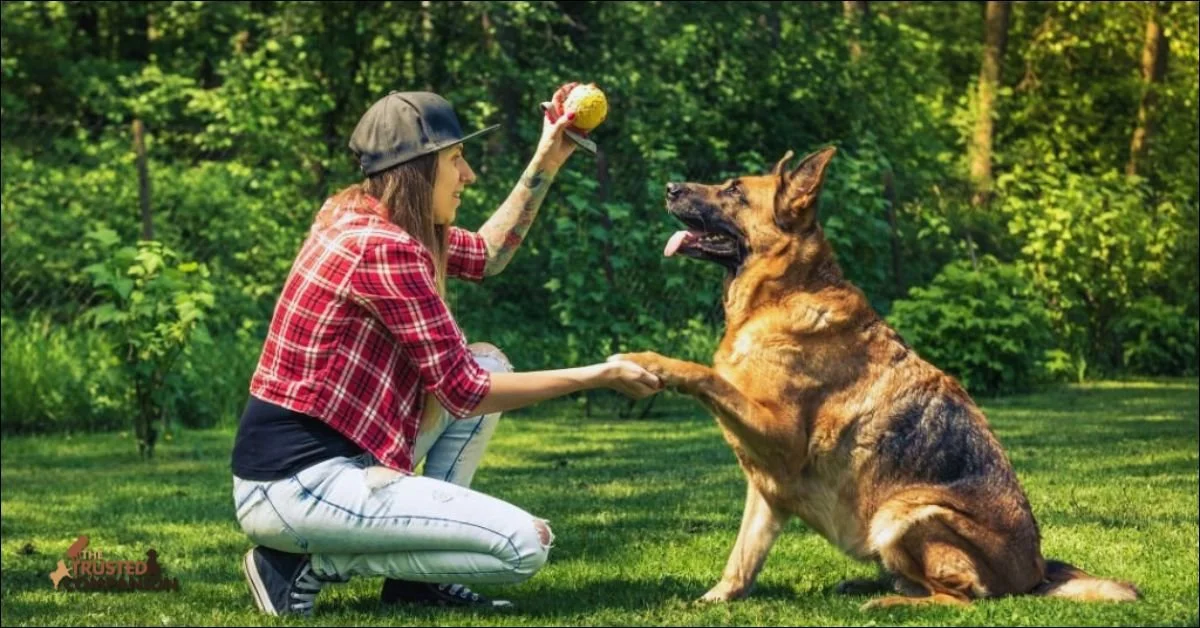Training your dog for obedience might seem challenging, but it’s easier than you think. Imagine having a well-behaved dog that listens to you every time, making your life less stressful and more enjoyable.
Whether your dog is a playful puppy or a stubborn adult, the right approach can transform their behavior quickly. You’ll discover simple, practical steps to train your dog effectively. Ready to build a stronger bond with your furry friend and enjoy peaceful walks, calm mealtimes, and happy days?
Let’s dive in and get started!

Credit: www.ebooks2go.com
Choosing The Right Training Method
Choosing the right training method for your dog is key to building a strong, trusting relationship. Every dog is different, so what works well for one may not suit another. Consider your dog’s personality, your training goals, and how you both respond to different techniques before deciding.
Positive Reinforcement
Positive reinforcement focuses on rewarding your dog for good behavior. This could be treats, praise, or playtime. I once used this method with my shy pup, and she quickly learned commands because she wanted to earn her favorite treats.
This method encourages your dog to repeat behaviors without fear or stress. It’s effective for building confidence and strengthening your bond.
Clicker Training
Clicker training uses a small device that makes a clicking sound to mark the exact moment your dog does something right. The click is immediately followed by a reward. This precise timing helps your dog understand which action earned the reward.
Many trainers find clicker training speeds up learning. Have you tried using a clicker to catch your dog’s best behavior instantly?
Balanced Training
Balanced training combines rewards with corrections to guide your dog. It’s about finding a middle ground between kindness and structure. While some owners hesitate, this method can be effective if done fairly and consistently.
Think about your dog’s temperament: would a balance of encouragement and clear limits help them focus better? This approach often works well for dogs with strong-willed personalities.
Essential Commands
Training your dog to follow essential commands creates a foundation for good behavior and strong communication. These commands help keep your dog safe, make daily life easier, and deepen your bond. Focusing on a few key commands first ensures your dog learns quickly and stays motivated.
Sit
The “Sit” command is one of the easiest and most useful to teach. It helps your dog calm down and wait patiently, which is great in many situations like meeting new people or waiting for food.
Start by holding a treat close to your dog’s nose, then slowly move it upward and back over their head. As their head follows the treat, their bottom will naturally lower to the ground. Once seated, say “Sit” clearly and give the treat immediately.
Stay
“Stay” teaches your dog to hold their position until you give another command. This skill is crucial for safety, especially near roads or in busy places.
Ask your dog to sit, then show your palm toward them and say “Stay.” Take a small step back. If your dog stays, reward them right away. Gradually increase the distance and duration, but always keep training sessions short and positive.
Come
The “Come” command ensures your dog returns to you, no matter the distractions. This can prevent dangerous situations and makes off-leash time more enjoyable.
Use a happy tone and say “Come” while kneeling or moving slightly backward. Reward your dog with treats or praise when they reach you. Practice this in different environments to build reliability.
Heel
“Heel” keeps your dog walking calmly beside you without pulling on the leash. It makes walks more pleasant and controlled, especially in crowded areas.
Start by standing still and holding a treat at your side. Say “Heel” and begin walking slowly. Reward your dog frequently for staying close. If they pull ahead, stop walking and wait for them to return before continuing.
Creating A Training Schedule
Creating a training schedule helps your dog learn faster. A clear routine builds good habits. It keeps training sessions short and focused. This way, your dog stays interested and eager to learn. A planned schedule also fits easily into your daily life. Here is how to create an effective training schedule.
Daily Sessions
Short daily sessions work best for training dogs. Aim for 5 to 10 minutes each time. This keeps your dog’s attention sharp. Multiple sessions a day help reinforce commands. Try morning, afternoon, and evening practice times. Regular practice prevents boredom and frustration. It also strengthens your bond with your dog.
Consistency Is Key
Train your dog at the same times each day. Use the same words and gestures for commands. Consistency helps your dog understand expectations. It reduces confusion and speeds learning. Everyone in your home should follow the same rules. This avoids mixed signals and keeps training clear. A steady routine makes good behavior a habit.
Adjusting Based On Progress
Watch how your dog responds to training. Increase session time if your dog stays focused. Shorten sessions if your dog seems tired or distracted. Change commands or rewards to keep your dog motivated. Celebrate small wins to encourage progress. Be patient and flexible. Every dog learns at its own pace.
Setting Up A Training Environment
Creating the right environment sets the tone for successful dog training. A calm and controlled space helps your dog focus on learning. This space should reduce interruptions and distractions. Comfort and safety also encourage your dog to enjoy training sessions.
Minimizing Distractions
Choose a quiet area free from loud noises and activity. Turn off televisions and radios. Keep other pets away during training time. Use a room with few objects that can catch your dog’s attention. This helps your dog concentrate on commands without wandering off.
Using Tools And Equipment
Gather essential training tools before starting. Use a leash and collar for control. Treats motivate your dog to follow instructions. Clickers can mark good behavior clearly. Keep all tools within reach to avoid interruptions during training.
Safe Space For Practice
Pick a secure area where your dog feels protected. Avoid places near busy streets or sharp objects. Use soft mats or carpets for comfort. A safe space lowers stress and builds trust. Your dog will be more willing to learn in such a place.
Building Trust And Bond
Building trust and a strong bond with your dog is the foundation of successful obedience training. Without trust, your dog may hesitate or resist following commands. When your dog feels safe and understood, training becomes a positive experience for both of you.
Understanding Your Dog’s Needs
Every dog has unique needs that influence how they learn and respond. Observe your dog’s body language and behavior to see what motivates them or causes stress.
Ask yourself: Does your dog prefer treats, playtime, or affection as a reward? Knowing this helps you tailor your training approach.
Meeting basic needs like exercise, proper nutrition, and mental stimulation also makes your dog more focused and willing to learn.
Rewarding And Encouragement
Positive reinforcement is one of the most effective tools in obedience training. Reward your dog immediately after they perform a desired behavior to create a clear connection.
- Use treats that your dog loves but doesn’t get all the time.
- Give verbal praise with a happy tone.
- Include gentle petting or play as a reward.
Encouragement boosts your dog’s confidence and makes training feel like fun, not a chore.
Patience And Persistence
Training doesn’t happen overnight. Expect setbacks and be ready to repeat lessons without frustration.
Remember how I struggled teaching my dog to sit calmly? It took weeks of gentle reminders and consistent practice before it clicked.
Your calm and steady approach shows your dog that you are reliable, which deepens trust and speeds up learning.

Credit: www.facebook.com
Troubleshooting Common Challenges
Training a dog in obedience often comes with challenges that can test patience. Knowing how to troubleshoot common problems helps keep training on track. Each dog has unique needs and behaviors that require careful attention.
Understanding why your dog disobeys or acts out can reveal the right solution. Anxiety and fear often block learning, so managing these feelings is essential. Different breeds also respond to training in various ways, making adjustment necessary.
Addressing Disobedience
Disobedience can stem from confusion, distraction, or lack of motivation. Clear commands and consistent rules help your dog understand expectations. Use positive reinforcement to reward good behavior immediately.
- Keep training sessions short and engaging.
- Remove distractions during early training.
- Repeat commands calmly but firmly.
- Ignore attention-seeking misbehavior.
Handling Anxiety And Fear
Anxiety slows learning and causes unwanted behaviors. Create a safe environment where your dog feels secure. Use gentle praise and avoid harsh corrections that increase stress.
- Introduce new situations gradually.
- Offer treats to build positive associations.
- Practice relaxation techniques like calm petting.
- Consult a vet if anxiety is severe.
Adjusting Techniques For Different Breeds
Some breeds learn faster, while others need more patience. High-energy breeds benefit from active training sessions. Calm breeds may respond better to gentle, steady commands.
| Breed Type | Training Tip |
|---|---|
| Working Dogs | Use tasks and challenges to keep interest. |
| Toy Breeds | Focus on short, frequent sessions. |
| Herding Breeds | Include physical and mental exercises. |
| Companion Breeds | Use gentle praise and socialization. |
Maintaining Obedience Long-term
Maintaining obedience over time takes ongoing effort and attention. Training is not a one-time task. Consistency keeps your dog sharp and responsive. It builds trust and strengthens your bond. Regular care helps prevent bad habits from returning.
Regular Practice
Practice commands daily, even for a few minutes. Short sessions keep your dog focused and eager. Use real-life moments to reinforce training. For example, ask your dog to sit before meals. Consistent practice helps commands become second nature.
Refreshing Commands
Review old commands regularly to keep them fresh. Dogs can forget if not reminded often. Use treats and praise to motivate your dog. Change up the training routine to keep it interesting. Repeating commands in different ways helps solidify learning.
Adapting To New Situations
Expose your dog to new places and people. Practice commands in different environments to test obedience. This prepares your dog for unexpected distractions. Gradually increase difficulty to build confidence. Adapting helps your dog obey anywhere, anytime.

Credit: www.thetrustedcompanion.com
Frequently Asked Questions
How Long Does Obedience Training Take For Dogs?
Obedience training duration varies by dog age and breed. Typically, basic commands take 4 to 6 weeks of consistent practice. Puppies learn faster, but patience is key for lasting results. Regular short sessions improve focus and skill retention effectively.
What Are The Best Obedience Commands To Start With?
Start with simple commands like sit, stay, come, and down. These build a foundation for good behavior and communication. Use treats and praise to reinforce learning. Clear, consistent cues help your dog understand expectations quickly.
How Often Should I Train My Dog Daily?
Train your dog 10 to 15 minutes per session, two to three times daily. Short, frequent sessions keep your dog engaged and prevent boredom. Consistency is crucial for effective learning and behavior improvement.
Can All Dog Breeds Be Trained For Obedience?
Yes, all dog breeds can learn obedience with proper methods. Training success depends on patience, consistency, and adapting techniques to your dog’s personality. Some breeds may require more motivation or time but all can improve behavior.
Conclusion
Training your dog for obedience takes time and patience. Keep sessions short and fun to hold your dog’s attention. Use treats and praise to encourage good behavior. Practice daily to build strong habits and trust. Remember, every dog learns at its own pace.
Stay calm and consistent throughout the process. Enjoy the journey and celebrate small wins. Well-trained dogs are happy and confident companions. Your effort will create a better bond with your dog. Training is a gift that lasts a lifetime.







